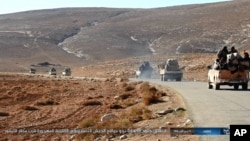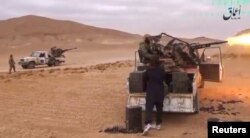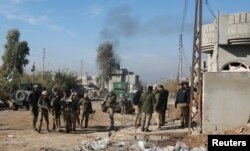As it suffers major setbacks across Iraq and Syria, the Islamic State is doubling back in some areas and retaking territory it lost months ago.
In recent weeks, a group of nearly 4,000 Islamic State (IS) fighters stormed the ancient city of Palmyra in central Syria and took control of much of it in a surprise attack. Despite intensive airstrikes by the U.S., Russia and Syria, IS has been able to hold onto much of Palmyra.
IS fighters also succeeded in retaking at least a dozen villages from Syrian government troops and other local forces, including areas in eastern Homs and Deir Ezzor in Syria, and parts of Anbar province in Iraq.
“IS is now looking for alternative territories to conquer,” said Rami Abdulrahman, head of the Britain-based Syrian Observatory for Human Rights, a group that has researchers across the country.
IS is using the Syrian desert as a route to resupply and reinforce its fighters in Palmyra and other parts of Homs province, Abdulrahman said. The desert connects eastern Homs to IS strongholds of Raqqa and Deir Ezzor in eastern Syria and the sandy plain stretches for hundreds of miles into western Iraq.
IS has been commanding its incoming forces in Homs from its de facto capital of Raqqa. And even though IS is losing fighters daily in Mosul, it has deployed some to Syria for surprise attacks, analysts said.
“Most of the IS fighters who took over Palmyra were deployed from Iraq,” Abdulrahman said.
IS succeeded In Palmyra because Syrian troops and their allies were concentrating on retaking Aleppo from rebel fighters, a Kurdish commander fighting IS said.
“As long as [IS] controls major cities like Raqqa and Deir Ezzor, it will pose threats to other areas, including those who have recently been retaken from the group,” said Nasir Hajji Mansur, a commander with the Syrian Democratic Forces (SDF).
The SDF, backed by U.S. air power, has made significant gains against IS fighters in large parts of north and northeastern Syria. The Kurdish-led force has also launched an offensive to rout IS from Raqqa.
But once the air support focuses on other areas in Syria and Iraq IS “can retake any part it desires in Syria,” Abdulrahman said.
With battles going on along several fronts in Syria and Iraq, IS “advances speak more to the weakness of its enemy than the group's own strength,” said Aymenn Jawad al-Tamimi, an analyst at the Middle East Forum, a U.S.-based think tank.
In Syria, IS remains in control 72 percent of territory it has captured since its inception in 2014, according to U.S. officials. Government forces of Syrian President Bashar al-Assad are concentrating on fighting rebels.
“The Assad regime is weak, has manpower issues and is incapable of fighting on two fronts,” Oula A. Alrifai, a Syria analyst based in Washington, said of Syrian forces’ limited capabilities.
IS’s strategy is to find weak spots in Syria’s civil war and exploit them, analysts said.
“The civil war in Syria allows [IS] to operate more freely on the ground,” said Marco Manuel Marsili, a Middle East researcher at the University of Lisbon, Portugal.
In Iraq, where U.S.-backed Iraqi and Kurdish forces are taking on IS in its stronghold of Mosul, advances have slowed in recent weeks. And that, in part, is due to severe weather conditions that have limited U.S. airstrikes on IS positions in the city, said Sime Usali, a Kurdish commander who runs a peshmerga unit near Mosul.
“This weather doesn’t only make it difficult for Iraqi forces to combat effectively in Mosul, it also allows [IS] to move fighters between Iraq and Syria,” he told VOA. “Any relief [IS] can get in Iraq reflects on its movements in Syria.”













